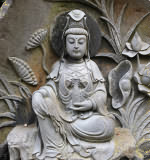| Скачайте и установите необходимые шрифты, чтобы санскрит отображался во всей его красе Прочтите Транслитерация (2) (русский), чтобы полностью понять систему транслитерации |
Pratyabhijñāhṛdayam (Пратьябхиджняхридаям) - Недвойственный Кашмирский Шиваизм
Только 20 сутр - без комментариев - Kṣemarāja (Кшемараджа) раскрывает тему Сердца Узнавания - Чистый перевод
Introduction
Hi, Gabriel Pradīpaka once again. As you surely know from Trika 2 (English)/Literature, literature of Non-dual Shaivism of Kashmir is divided into three sections. The present scripture belongs to the third section called Pratyabhijñā (Recognition). The celebrated sage Kṣemarāja had written a lot of commentaries on various scriptures of Trika. Of those commentaries, two are really crucial: Śivasūtravimarśinī and Spandanirṇaya. The former is on the Śivasūtra-s, while the latter is on Spandakārikā-s. Śivasūtra-s and Spandakārikā-s are two very important scriptures in Trika. However, Kṣemarāja also wanted to write a scripture of his own. He admired Utpaladeva a lot. Utpaladeva had composed Īśvarapratyabhijñā (also called Pratyabhijñāsūtra-s), which is considered to be the most important work of the Pratyabhijñā section. Remember that Utpaladeva had been disciple of Somānanda, while Kṣemarāja's guru was Abhinavagupta. Both Somānanda and Abhinavagupta were renowned guru-s, and both Utpaladeva and Kṣemarāja were worthy disciples of such great masters, no doubt. It is said that Kṣemarāja wished to compose Pratyabhijñāhṛdayam due to his fervent love for Utpaladeva and his works. In fact, you will find that the twenty sūtra-s (aphorisms) of which this scripture consists are actually a compendium of Utpaladeva's Īśvarapratyabhijñā (which consists of 199 sūtra-s).
Pratyabhijñāhṛdayam dates from the tenth century A.D. approximately. The literal meaning of Pratyabhijñāhṛdayam is "Heart --hṛdayam-- of Recognition --pratyabhijñā--". Nonetheless, there are three possible ways of interpreting that:
1) As I said before, the word "Pratyabhijñā" means Recognition. According to Trika, Śiva (one's own Self of everybody) cannot be "known" as He is not a knowable but the Knower Himself. Instead, He is to be "recognized" as such. Thus, one is not going to know Śiva, but recognize that he is Him really. When one realizes that he is Śiva, that is known as Enlightenment. As a matter of fact, there is nothing extremely complicated in that, but Śiva (You), through His Māyā turns the aforesaid Enlightenment into something extremely difficult to attain. Genuine Recognition that one is Śiva is rare in this world. Sure that genuine Recognition is not merely to say "I am Śiva" but really realize and understand one's inherent unity with Him. This is not cheap... it is very difficult to accomplish undoubtedly, despite one already is Śiva. A paradox! To conclude then, the term "Pratyabhijñāhṛdayam" would mean the Core or Heart of that divine Recognition which, "theoretically, at least", everyone can attain, but that "in practice" only a few people enjoy. In this sense, this scripture would be so called as it contains profound teachings about Pratyabhijñā or Recognition.
2) Trika system (Non-dual Shaivism of Kashmir) is also known as Pratyabhijñā. Why? For two reasons: the first reason is connected with the Trika's statement that one is not going to know Śiva but recognize Him to be his own Self; and the second one is related to the enormous importance of the third section (whose name is Pratyabhijñā) in the Trika's literature. Thus, this scripture is known as Pratyabhijñāhṛdayam as it is a compendium of the main teachings given in that important section.
3) Utpaladeva's Īśvarapratyabhijñā (also called Pratyabhijñāsūtra-s) was the inspiration for Kṣemarāja to write Pratyabhijñāhṛdayam, and in this sense the title of his scripture might be understood as "Heart of Īśvarapratyabhijñā or Pratyabhijñāsūtra-s".
Pratyabhijñāhṛdayam consists of 20 aphorisms plus a commentary by Kṣemarāja himself. Be warned that I have only translated the aphorisms and not the respective commentaries on each of them. Finally, note that the final "m" in Pratyabhijñāhṛdayam indicates that the compound is neuter in gender. However, you might also write it in a crude form, without that "m": "Pratyabhijñāhṛdaya". That is why, you sometimes will find this alternative way of writing the title of the scripture.
This is a "pure translation" document, that is, there will be no original Sanskrit, but sometimes there will be a minimal quantity of transliterated Sanskrit in the translations themselves of the stanzas. Of course, there will not be any word for word translation. Anyway, there will be very often transliterated Sanskrit in the explanatory notes. If you are a blind person using a screen reader and do not want to read the notes, or simply if you are not blind but want to skip the notes, click on the respective "Skip the notes" link to jump directly onto the next stanza.
Well, let us get down to work.
Important: All that is in brackets and italicized within the translation has been added by me in order to complete the sense of a particular phrase or sentence. In turn, all that is between double hyphen (--...--) constitutes clarifying further information also added by me. Now and then, some important terms may be highlighted with color. The notes at the foot of some aphorisms are also mine, of course.
Pratyabhijñāhṛdayam
-Heart of Recognition-
The independent Śakti or Supreme Power (is) the cause of manifestation, maintenance and dissolution1 of the universe||1||
Skip the notes
1 The term "siddhi" does not mean "supernormal power" or "perfection" in this case, but the triple process of manifesting, maintaining and dissolving the universe, carried out by Citi (Universal Consciousness).
Through Her own Will (Power) --icchā--, She --i.e. "Citi"-- unfolds the universe on Her own Canvas --bhitti--||2||
That --i.e. "the universe"-- (is) multiple because of the differentiation of (reciprocally) adapted objects or knowables (and) experients or subjects||3||
The individual experient, in whom there is contraction of Citi1, also has the universe as his body, but in a contracted way||4||
Skip the notes
1 In other words, "in whom Citi is contracted".
It is Citi alone (who), by descending from the stage of pure Consciousness, contracts Herself (assuming the form of) the object or knowable; (and it is also Citi who) becomes the mind||5||
The limited experient ruled by Māyā1 consists of that --i.e. "of citta or mind"--||6||
Skip the notes
1 Māyāpramātā is also known as "the experient of void" as he rests at Māyā level which is the profound void of ignorance.
And (even though) He --i.e. "the Supreme Self"-- (is) One, (He becomes) double, triple, fourfold (and) of the nature of seven groups of five||7||
The positions1 of all philosophical systems (are only various) roles (played) by that (Self or Consciousness)||8||
Skip the notes
1 In other terms, "the final conclusions stated by those philosophies".
That --i.e. "the Self"--, who is full of Consciousness, (becomes) the transmigratory soul covered by Mala1 due to (His) contraction of Śakti or Power||9||
Skip the notes
1 Mala literally means "impurity". In turn, Mala can be divided into three categories: Āṇavamala (bringing about in Śiva the notion that He is imperfect, that is, not Divine), Māyīyamala (bringing about in Śiva the notion of difference in That which is completely non dual) and Kārmamala (bringing about in Śiva the notion that He is a limited doer of limited actions). Wake up Śiva!
Even (in that limited condition, the individual soul) performs the five functions1 as that (Supreme Self)||10||
Skip the notes
1 The five functions are: Sṛṣṭi (manifestation), Sthiti (maintenance), Saṁhāra (reabsorption), Vilaya (obscuration or concealment of His essential nature) and Anugraha (Divine Grace which draws the veil of Māyā or Delusion).
Those (five functions can also be explained) through (these five terms): Ābhāsana --i.e. "the act of manifesting"--, Rakti --i.e. "enjoyment"--, Vimarśana --i.e. "the act of experiencing oneself as the Self"--, Bījāvasthāpana --i.e. "the act of sowing the seed"-- (and) Vilāpana --i.e. "dissolution"--1||11||
Skip the notes
1 That is, Ābhāsana would be tantamount to Sṛṣṭi (manifestation), Rakti to Sthiti (maintenance), Vimarśana to Saṁhāra (reabsorption), Bījāvasthāpana to Vilaya (obscuration or concealment) and Vilāpana to Anugraha (Divine Grace).
To be a transmigratory soul (means) to be bewildered or infatuated by one's own powers --śakti-- on account of the complete ignorance of that --i.e. "of the authorship of the five functions or fivefold act"--1||12||
Skip the notes
1 The term "pañcakṛtya" (five functions) is also translated as "fivefold act" sometimes.
When there is complete knowledge of that --i.e. "of the authorship of the five functions or fivefold act"--, the mind itself, through introversion, (becomes) the Supreme Power by ascending (up to) the state of pure Consciousness||13||
The Fire of the Supreme Power, though covered or concealed (by Māyā or Delusion) in the inferior stage, partially consumes the fuel of the knowables||14||
When (one) obtains the Power of Citi or Universal Consciousness, he makes the universe similar to himself, (that is, he assimilates the universe to himself)1||15||
Skip the notes
1 The phrase "ātmasātkaroti" is derived from "ātmasāt kṛ", which commonly means "to place upon oneself, to make one's own, attract, turn to oneself, acquire or gain for oneself, etc.". However, in Trika, it means "to make similar to oneself, assimilate to oneself", which is tantamount to "experiencing unity". Therefore, "viśvamātmasātkaroti" really means "to experience unity with the universe". When it is said that you should assimilate the universe to yourself, it is meant that you should experience unity with it, this is the sense.
When (one) obtains the Bliss of Absolute Consciousness, (there is) stability or firmness of the awareness of identity with (that) Absolute Consciousness, even though the body, etc. --ādi-- are being experienced. (This state is known as) Jīvanmukti --i.e. "Liberation or Mukti while living"--1||16||
Skip the notes
1 In other words, "Liberation while one retains his physical body". In turn, "Videhamukti" means Liberation attained at the time of leaving one's body.
Through the unfoldment or development of the middle (state, there is) acquisition of the Bliss of Absolute Consciousness||17||
Here (you are) the means (to that unfoldment or development): 1) dissolution or dissipation of (all) vikalpa-s or thoughts, 2) unfoldment (and) contraction of Śakti or Power1, 3) cessation of the flow of prāṇa and apāna by means of the repetition of "anacka" --i.e. "without vowels"-- sounds2, etc., (and) 4) the perception of the dvādaśānta3, etc.||18||
Skip the notes
1 By "unfoldment and contraction of the Śakti or Power", the author meant to say "withdrawal of Prāṇaśakti ('pranic or vital energy' would be an approximate but useful translation for now) which escapes through the sense organs by introverting it toward the Self, while at the same time the senses are allowed to keep working as usual". In other terms, "withdrawal or contraction --saṅkoca-- of Prāṇaśakti" together with "unfoldment of Śakti --vikāsa-- through the senses, as these are allowed to keep working as always".
2 The compound "vāhaccheda" is not at all formed from "vāhac" (which in turn would be possibly derived from "vāhat") and "cheda", but from "vāha" and "cheda", since by the first sub-rule of the 19th Rule of Consonant Sandhi, you are bound to insert "c" between "ch" and the preceding short vowel ("a" in "vāha", in this case).
In other words, that "c" before "ch" is not an original constituent but a consonant to be obligatorily inserted according to that particular rule of Consonant Sandhi.
So, "Vāha" means "vital energy or Prāṇaśakti". In turn "cheda" means "cessation of prāṇa (i.e. the specific energy being released through the exhalation) and apāna (i.e. the specific energy entering the body through the inhalation) by means of the repetition of anacka sounds". Anacka sounds are simply consonants without a vowel. For example: h.
3 "Dvādaśānta" means "certain points placed at the distance of twelve fingers" (e.g. there is one dvādaśānta in the space between the eyebrows, at twelve fingers from the throat). Even though Kṣemarāja does not specify which dvādaśānta (there are several ones) he is referring to, it is generally understood as meaning to say "āntaradvādaśānta" (the heart or point where the inhalation ends) and "bāhyadvādaśānta" (the outer point where the exhalation ends). That is, you should pay attention to those two points or dvādaśānta-s while meditating in order to unfold or develop the middle state or Madhya.
In the state coming after Samādhi or Perfect Concentration, which is full of the saṁskāra-s --saṁskāravat--1 (of that) Samādhi, (there is) acquisition of a permanent Samādhi by reflecting over and over again upon one's own identity with the Absolute Consciousness||19||
Skip the notes
1 "Full of the saṁskāra-s" here means "full of the subsequent effects". In other terms, when one is in Vyutthāna (the state coming after Samādhi or Perfect Concentration), both mind and body are full of the respective and subsequent effects produced by that Samādhi.
Then, as a result of entering in the Perfect I-consciousness, which is essentially Light (and) Bliss, (and whose) nature (consists of) the great power of the Mantra, there is always acquisition or obtainment of sovereignty or supremacy over the group of deities of one's own Consciousness, which brings about all manifestations (and) dissolutions (of the universe). Thus, all is of the nature of Śiva1||20||
Skip the notes
1 All is essentially Śiva.
Further Information
Этот документ был составлен Габриэлем Pradīpaka, одним из двух основателей этого сайта, духовным гуру, экспертом в санскрите и философии Трика.
Для получения дополнительной информации о санскрите, йоге и философии, или если вы просто хотите оставить комментарий, задать вопрос или нашли ошибку, напишите нам: Это наша электронная почта.





























